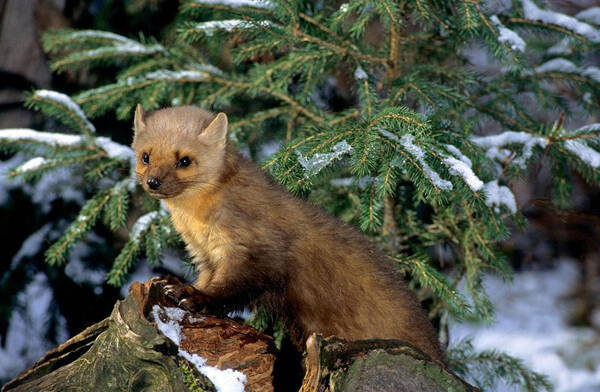Martes americana
IUCN
LCBasic Information
Scientific classification
- name:Martes americana
- Scientific Name:Martes americana,American Marten
- Outline:Carnivora
- Family:mustelidae mustelinae marten
Vital signs
- length:20-45cm
- Weight:280-1300g
- lifetime:4-15years
Feature
The head is bright gray, the back is grayish brown, and the throat and abdomen have irregular pale yellow or apricot red spots.
Distribution and Habitat
Distributed in eastern Canada and northeastern and northwestern United States in North America.
Inhabits large coniferous trees, usually with closed canopies, and forest areas with abundant standing timber and woody material. They are densely distributed in hollow trees or logs, rock crevices or caves.
Appearance
The American mink has a body length of 20-45 cm and a tail length of 15-17 cm. Weight 280-1300 grams. It is a small to medium-sized mammal, with the male being larger. The head is broad, the ear shells are large, short and round, the body is slender, and the limbs are short. The feet are broad and the claws are sharp and curved. Sensitive sense of smell and hearing. The canine teeth are more developed and the cleft teeth are smaller; the upper molars are arranged horizontally, and the inner leaves are wider than the outer leaves; the crown diameter of the molars is greater than the height of the outer incisors. The body hair is soft and mostly without markings. Both front and rear feet have 5 fingers (toes); they are plantar or semi-plantar; the claws are sharp and non-retractable. The tail is slender and pointed. Both sexes have odor glands near the anus, which can emit odor to repel enemies and defend themselves.
The coat is longer and shiny, and the undercoat is soft and dense. S
Details
American Marten (scientific name: Martes americana) is a small to medium-sized mammal with 13 subspecies.

American Marten is generally solitary. It lives in trees and can move easily in trees. It also often moves on the ground. It can swim. It does not hibernate. Mainly active at night. They use a strong scent to smear trees and mark their territory with the scent on the trees. Most hunting activities are carried out on the ground, and most of them occur during dusk and dawn when prey is most active. In addition, the American marten is also a good swimmer and can even swim underwater.
The American marten is a carnivore with a wide diet, mainly feeding on rodents, birds, bird eggs and chicks, fish, insects, and also eating fruits and carrion. The male territories are larger than the females. The average home range of the American marten is 8.1 square kilometers for males and 2.3 square kilometers for females, with varying degrees of overlap.
The size of the American marten's home range varies greatly with habitat and prey density. When the habitat is good, the population density is 1.7 per square kilometer. When the habitat is poor, the average is 0.4 per square kilometer. The American mink does not hibernate and is active in winter.
The American mink enters the breeding season in July-August, with a gestation period of 220-275 days, and 1-4 pups per litter. It reaches sexual maturity at about 2 years old. The life span of artificially fed American minks can reach 15 years old, and it is difficult for American minks living in the wild to survive more than 4 years old.
Mink fur is very valuable and controlled hunting is adopted. The American mink may be considered a pest because it reduces the population of other species, such as squirrels and rabbits. However, they live in areas with sparse human populations and are unlikely to have an impact on humans. The species has a wide distribution range and is not close to the vulnerable and endangered critical value standard for species survival (distribution area or fluctuation range less than 20,000 square kilometers, habitat quality, population size, and fragmentation of distribution area). The population trend is stable, so it is evaluated as a species without survival crisis.
Listed in the 2016 IUCN Red List of Threatened Species ver3.1 - Least Concern (LC).
Protect wild animals and eliminate game.
Maintaining ecological balance is everyone's responsibility!








